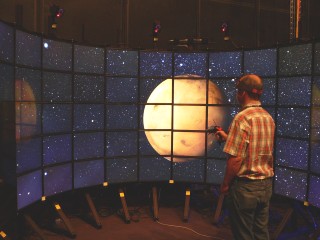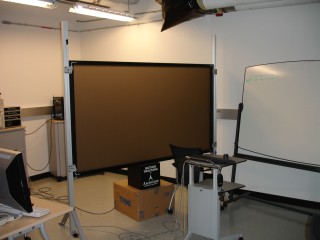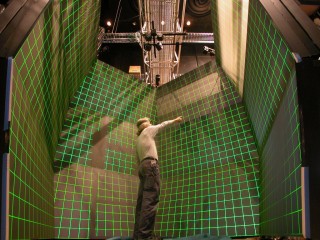Difference between revisions of "Infrastructure"
(→Varrier) |
|||
| Line 4: | Line 4: | ||
<td>[[Image: greg-320.jpg]]</td> | <td>[[Image: greg-320.jpg]]</td> | ||
<td valign="top">The StarCAVE is located in room 1608A and consists of five walls with three screens each. Two JVC HD2K projectors generate a stereo image for each screen, totalling 30 projectors in the StarCAVE. Every projector pair is driven by an Intel quad core Dell XPS computer running under ROCKS/CentOS, with dual Nvidia Quadro 5600 graphics cards. We use an additional XPS machine as the head node to control the rendering nodes, for a total of 16 nodes. For head and hand tracking we use a wireless, optical tracking system by ART Tracking.</td> | <td valign="top">The StarCAVE is located in room 1608A and consists of five walls with three screens each. Two JVC HD2K projectors generate a stereo image for each screen, totalling 30 projectors in the StarCAVE. Every projector pair is driven by an Intel quad core Dell XPS computer running under ROCKS/CentOS, with dual Nvidia Quadro 5600 graphics cards. We use an additional XPS machine as the head node to control the rendering nodes, for a total of 16 nodes. For head and hand tracking we use a wireless, optical tracking system by ART Tracking.</td> | ||
| − | |||
| − | |||
| − | |||
| − | |||
| − | |||
| − | |||
| − | |||
| − | |||
</tr> | </tr> | ||
</table> | </table> | ||
| Line 24: | Line 16: | ||
* [http://www.hlrs.de/organization/vis/covise/ COVISE] | * [http://www.hlrs.de/organization/vis/covise/ COVISE] | ||
</td> | </td> | ||
| + | </tr> | ||
| + | </table> | ||
| + | |||
| + | ===C-Wall=== | ||
| + | <table> | ||
| + | <tr> | ||
| + | <td>[[Image: c-wall-320.jpg]]</td> | ||
| + | <td valign="top">The C-Wall is located in room 6307 and features a single screen, stereo wall, driven by a PC with dual AMD Opteron CPUs, an Nvidia GeForce 7900 video card, 4 GB RAM, and 1.7 TB HDD space, running under Suse Linux 10.1. It is driving two JVC HD2k projectors with a resolution of 1920x1080 pixels each, projecting on a 4 by 8 foot screen using rear-projection. We use circular polarization filters and glasses to separate the stereo images. For tracking we use an electro-magnetic Ascension Flock of Birds system with head tracking and a Wanda input device. The concept of the C-Wall is described [http://www.evl.uic.edu/core.php?mod=4&type=1&indi=234 here]. The software driving our C-Wall is [http://www.hlrs.de/organization/vis/covise/ COVISE.] Writing new software applications for the C-Wall can be done by implementing a C++ module for COVISE, of which the underlying graphics API is [http://www.openscenegraph.com OpenSceneGraph].</td> | ||
</tr> | </tr> | ||
</table> | </table> | ||
Revision as of 14:20, 16 October 2007
Contents |
StarCAVE
Varrier
 |
The Varrier wall, a.k.a. Lambdavision Display System, consists of 60 LCD monitors, arranged in a semi cylinder. It can generate autostereoscopic images at a resolution of about 40 million pixels per eye. The system consists of 31 dual AMD Opteron machines, each with 4GB RAM, 1.6TB disk arrays, dual gigabit ethernet NICs and NVidia Geforce 7900 video cards. Each display node drives two 20" NEC LCD monitors (1600 x 1200 pixels). The system is running on Suse Linux 10.0. We support three software environments to drive the cluster: |
C-Wall
 |
The C-Wall is located in room 6307 and features a single screen, stereo wall, driven by a PC with dual AMD Opteron CPUs, an Nvidia GeForce 7900 video card, 4 GB RAM, and 1.7 TB HDD space, running under Suse Linux 10.1. It is driving two JVC HD2k projectors with a resolution of 1920x1080 pixels each, projecting on a 4 by 8 foot screen using rear-projection. We use circular polarization filters and glasses to separate the stereo images. For tracking we use an electro-magnetic Ascension Flock of Birds system with head tracking and a Wanda input device. The concept of the C-Wall is described here. The software driving our C-Wall is COVISE. Writing new software applications for the C-Wall can be done by implementing a C++ module for COVISE, of which the underlying graphics API is OpenSceneGraph. |
Multipurpose Room (Black Box)
The multipurpose room at Calit2 is a 2-story, reconfigurable performance space for experiments with the audience’s relationship to the physical environment and mediated elements. The IVL runs a stereo projection setup consisting of dual Christie projectors with a resolution of 1600x1200 pixels each, driven by a dual AMD Opteron PC with a fast RAID array.
Digital Theatre
Calit2 has a 200-seat theatre with ultra-high resolution video and 20 channel surround sound. The IVL runs a Sony SRX-R110 projector for uncompressed 4K (8 megapixels) digital cinema, which is four times as many pixels than the current HD standard. The projector can be driven by a Silicon Graphics Prism visualization system, streaming at 24 frames-per-second from an SGI InfiniteStorage RM-660 disk array onto a screen 18 feet high by 32 feet wide. The Prism is connected by a 10Gbit/sec network connection to the global OptIPuter network, making the Calit2 theater the most advanced digital cinema theater currently in operation in the world. Another option for 4k video playback and recording is a set of NTT JPEG2000 hardware codecs, which can operate at 24 or 30 frames per second.
